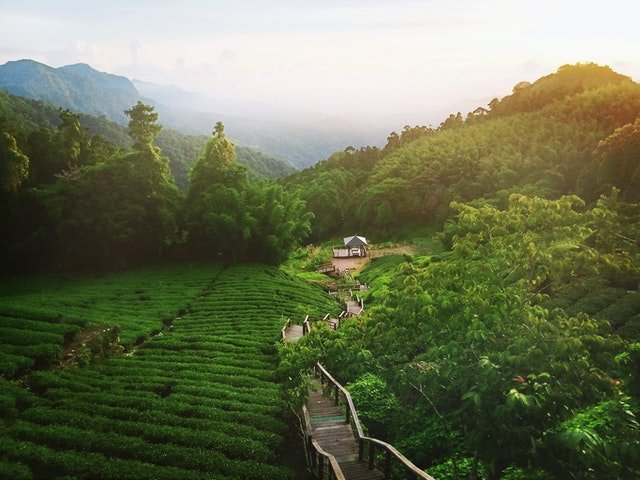
We have talked a lot in Infusionism about the different varieties of tea that exist. However, until now we had not stopped to analyze the plant that gives rise to these wonderful infusions that delight our palates. Here we tell you everything a good tea lover should know about Camellia sinensis.
What is Camellia sinensis ?
Camellia sinensis is a tree that can reach 9 meters in height. However, it is usually kept in the form of a bush in order to facilitate the collection of its leaves.
It is a perennial tree, that is, it does not lose its leaves at any time of the year, and it belongs to the Calophyllaceae family. It stands out for its leaves that can reach 15 centimeters in length and 5 centimeters in diameter.
In spring, its whitish-yellowish flowers appear that can be presented alone or in small groups.
Undoubtedly, the most important thing about this plant is its leaves, which make it possible to make an innumerable variety of different teas (black, white , yellow, red, oolong, green …).
Where does the tea plant come from?
Camellia sinensis is the global name given to this family of plants that allows the production of teas and that usually grows in areas with temperate climates, although it also adapts to regions with strong winters.
In particular, the indigenous plant in China is called Camellia sinensis sinensis, while the Indian and Cambodian varieties are called Camellia sinensis assamica and Camellia lasio calyx, respectively. In addition to these typologies, there are other crosses between these species.
Camellia sinensis sinensis does well in cool climates, especially at high altitudes. As a result, its leaves are used to make mild teas with a hint of sweetness. The Indian species, for its part, grows best in areas with abundant rainfall and a more tropical climate. It is a plant that acquires a greater volume and gives rise to more robust teas.
History of the Camellia sinensis
Tea consumption is so old that it is very difficult to know exactly how it was born. Legend has it that around the year 2737 BC the Chinese emperor Shen-Nung discovered this infusion by chance when some leaves from the tree he was under fell into the water that his servant was boiling. Tasting the concoction, the emperor fell in love with its taste.
After this discovery, the consumption of tea would have spread in China as a natural remedy capable of curing and treating all kinds of diseases, from nausea and vomiting, indigestion and gas to migraine, inflammation and pain, in general.
Later, it is said that during the Tang dynasty, tea acquired a social and pleasure purpose, beginning to be consumed for the simple pleasure of making it.
Following this narrative line, it was not until the 8th century that tea consumption arrived in Japan at the hands of Buddhist monks.
At this point, it is worth noting that another legend about tea circulates in Japan. Prince Bodhi-Darma, after three years of travel teaching the keys of Buddhism, had a dream where all the women he had slept with appeared before him.
Upon waking up, he was embarrassed by the huge number he had seen in his dream and vowed never to sleep again. However, this is impossible.
When he was about to fall back into sleep and shame, he chewed the leaves of a tree and, miraculously, was able to stay awake. It is believed that this tree was the Camellia sinensis and that in the beginning it kept your eyes open thanks to its caffeine content.
Also, we have to comment that India has its own history that explains the origin of tea, of course, in its lands. In this case, the protagonist is, once again, Prince Bodhi-Darma but, this time, he prepares an infusion with some leaves during his pilgrimage to try to comfort his sick body. That drink healed him and immediately he decided to take some leaves with him and share the infusion.
Whatever the true story, after the popularization of tea in China, Japan and India, the English colonized some regions of the East and thus discovered this infusion. In parallel, the ancient Silk Road popularized the drink among other Middle Eastern cultures.
Later, Dutch merchants began to import tea from distant China, and in this way tea drinking in Europe was born.
Is it possible to grow the tea plant at home?

In China and Japan, it is not uncommon to find small tea plants in family gardens. So the answer, as you can imagine, is yes.
Of course you can grow a Camellia sinensis at home. However, you must take into account the requirements of this plant so that it develops correctly and you can enjoy the wonderful flavor of its leaves.
First of all, the tea plant needs a lot of moisture; for this reason, it tends to grow better in regions with daily rainfall and a strain exposure of a maximum of 5 hours per day. The right time to water is to do it before the soil is dry but without flooding, to avoid root rot.
As for the soil, an acidic substrate is recommended, which can be achieved by incorporating compost or manure into the soil. Take special care with frost that can kill the plant. If in your region you have temperatures below zero in winter, it is advisable to protect the Camellia sinensis in a greenhouse.
At the level of the necessary care, when the plant reaches the third year of growth, it is subjected to pruning that stimulates its growth. Then, it is pruned every 5 years to prevent it from growing too tall and complicating the harvest of the tea leaves.
As you can see, Camellia sinensis is a special plant whose different species make it possible to make all kinds of comforting infusions that are also good for the body. What are you waiting for to try all the teas that come from it?
